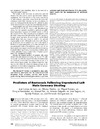Please use this identifier to cite or link to this item:
https://accedacris.ulpgc.es/jspui/handle/10553/76734
| DC Field | Value | Language |
|---|---|---|
| dc.contributor.author | Suárez de Lezo, José | en_US |
| dc.contributor.author | Medina, Alfonso | en_US |
| dc.contributor.author | Romero, Miguel | en_US |
| dc.contributor.author | Hernández, Enrique | en_US |
| dc.contributor.author | Pan, Miguel | en_US |
| dc.contributor.author | Delgado, Antonio | en_US |
| dc.contributor.author | Segura, José | en_US |
| dc.contributor.author | Pavlovic, Djordje | en_US |
| dc.contributor.author | Wanguemert, Fernando | en_US |
| dc.date.accessioned | 2020-12-16T12:50:33Z | - |
| dc.date.available | 2020-12-16T12:50:33Z | - |
| dc.date.issued | 2001 | en_US |
| dc.identifier.issn | 0002-9149 | en_US |
| dc.identifier.other | WoS | - |
| dc.identifier.uri | https://accedacris.ulpgc.es/handle/10553/76734 | - |
| dc.description.abstract | This report is a retrospective study that focuses on factors influencing restenosis after unprotected left main coronary stenting. The whole clinical and anatomic spectrum of left main coronary disease can be treated safely with stents; however, short lesions and long stems are independent predictors of better long-term results. | en_US |
| dc.language | eng | en_US |
| dc.relation.ispartof | The American journal of cardiology | en_US |
| dc.source | The American journal of cardiology [ISSN 0002-9149], v. 88 (3), p. 308-310, (Agosto 2001) | en_US |
| dc.subject | 320501 Cardiología | en_US |
| dc.subject.other | Artery Stenoses | en_US |
| dc.subject.other | Experience | en_US |
| dc.subject.other | Immediate | en_US |
| dc.subject.other | Outcomes | en_US |
| dc.title | Predictors of restenosis following unprotected left main coronary stenting | en_US |
| dc.type | info:eu-repo/semantics/Article | en_US |
| dc.type | Article | en_US |
| dc.identifier.doi | 10.1016/S0002-9149(01)01649-6 | en_US |
| dc.identifier.scopus | 0035421752 | - |
| dc.identifier.isi | 000170090500023 | - |
| dc.contributor.authorscopusid | 7006785516 | - |
| dc.contributor.authorscopusid | 7202723590 | - |
| dc.contributor.authorscopusid | 7202430759 | - |
| dc.contributor.authorscopusid | 7402296666 | - |
| dc.contributor.authorscopusid | 7202544866 | - |
| dc.contributor.authorscopusid | 36147056600 | - |
| dc.contributor.authorscopusid | 55415591100 | - |
| dc.contributor.authorscopusid | 7005198171 | - |
| dc.contributor.authorscopusid | 6602241581 | - |
| dc.description.lastpage | 310 | en_US |
| dc.identifier.issue | 3 | - |
| dc.description.firstpage | 308 | en_US |
| dc.relation.volume | 88 | en_US |
| dc.investigacion | Ciencias de la Salud | en_US |
| dc.type2 | Artículo | en_US |
| dc.contributor.daisngid | 67522 | - |
| dc.contributor.daisngid | 5831803 | - |
| dc.contributor.daisngid | 156230 | - |
| dc.contributor.daisngid | 2740671 | - |
| dc.contributor.daisngid | 77557 | - |
| dc.contributor.daisngid | 8447738 | - |
| dc.contributor.daisngid | 1825688 | - |
| dc.contributor.daisngid | 831427 | - |
| dc.contributor.daisngid | 3466905 | - |
| dc.description.numberofpages | 4 | en_US |
| dc.utils.revision | Sí | en_US |
| dc.contributor.wosstandard | WOS:de Lezo, JS | - |
| dc.contributor.wosstandard | WOS:Medina, A | - |
| dc.contributor.wosstandard | WOS:Romero, M | - |
| dc.contributor.wosstandard | WOS:Hernandez, E | - |
| dc.contributor.wosstandard | WOS:Pan, M | - |
| dc.contributor.wosstandard | WOS:Delgado, A | - |
| dc.contributor.wosstandard | WOS:Segura, J | - |
| dc.contributor.wosstandard | WOS:Pavlovic, D | - |
| dc.contributor.wosstandard | WOS:Wanguemert, F | - |
| dc.date.coverdate | Agosto 2001 | en_US |
| dc.identifier.ulpgc | Sí | en_US |
| dc.description.jcr | 2,637 | |
| dc.description.jcrq | Q1 | |
| dc.description.scie | SCIE | |
| item.fulltext | Con texto completo | - |
| item.grantfulltext | open | - |
| Appears in Collections: | Artículos | |
SCOPUSTM
Citations
32
checked on Jun 8, 2025
WEB OF SCIENCETM
Citations
17
checked on Jan 12, 2026
Page view(s)
62
checked on Jan 10, 2026
Download(s)
104
checked on Jan 10, 2026
Google ScholarTM
Check
Altmetric
Share
Export metadata
Items in accedaCRIS are protected by copyright, with all rights reserved, unless otherwise indicated.
